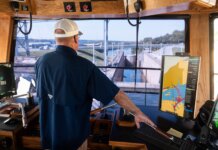Plastics are essential in modern industry, but their downsides are hard to ignore. According to the U.S. Environmental Protection Agency, 32 million tons of plastic were discarded in 2012. This waste ends up in landfills and waterways, where it is expected to stay for a very long time. Conventional fossil-fuel-based plastics do not break down, leaving non-biodegradable debris to accumulate. Over time, this has resulted in massive collections of hazardous waste, like the floating garbage patches in the Pacific and Atlantic Oceans.
Bioplastics producer Algix LLC may have a practical solution. Algix is busy harvesting nutrient-rich aquatic materials from Alabama and around the world to formulate algae-based bioplastics. The company uses patent-pending technology to convert algae, once considered waste, into environmentally safe materials for use in a wide range of industries and markets.
Algix sprang from technology developed at the University of Georgia. In the spring of 2010, co-founders Michael Van Drunen and Ryan Hunt were researching biofuel production from wastewater. “We ended up with more biomass than biofuel, ” says President and CEO Van Drunen. “We had so much excess algae, we decided to take a serious look at what could be done with it.” They soon began developing algae’s potential as a plastic with a grant from the State of Georgia.
Van Drunen and Hunt formed Algix in August 2010, acquiring exclusive worldwide licensing to the algae bioplastics technology through Kimberly-Clark in partnership with the University of Georgia. Since then, they have established a harvesting facility in Marion Junction, a production plant in Meridian, Mississippi, and an aquaculture center in Jamaica.
Algent, the Alabama facility, is already harvesting algae. Solaplast, the Meridian location, will hold its grand opening this October. Following the plant opening, Algix plans to produce 200 million pounds of bioplastic resins each year.
“Today, most plastics are derived from fossil fuels, a finite resource, ” says Ashton Zeller, director of research and development. “It’s not cheap and it’s not clean, so there has been an increasing push to find better means of making plastics. Renewable resources are the clear way to go.”
The search for renewable raw materials brought Algix to Alabama’s Black Belt. Acres of catfish farms provide the ideal location for the company to harvest algae and other aquatic biomasses, such as duckweed. Algent is located in Marion Junction, between Selma and Demopolis.
“Algix was looking for algae-rich ponds when they found our catfish farms, ” says Butch Wilson, director of pond-side operations. “It was a perfect fit.”
Wilson, who also serves as chairman of the Catfish Farmers of America, manages a farm that his family has operated for more than 180 years. Algix hired the aquaculture expert to oversee the company’s algae harvesting and manage contracts with fish farmers.
“At Algent, we make sure that the pond algae we harvest is ready for processing and that we don’t interfere with the farming, ” he says. “Our harvesting is meant to help the farmers, as well as the company.”
Wilson and his team at Algent believe that their relationship with Alabama’s aquaculture farmers is mutually beneficial. “Algae has always been considered a waste product, ” he says. “Farmers have to work to remove it from their fish ponds, but we pay them to let us extract it. It’s a win-win deal.” Algent also compensates the farmers for the use of electricity while running harvesters at the ponds.
The Marion Junction facility already has begun harvesting algae in advance of Solaplast’s grand opening. When bioplastic production is in full swing, Algent intends to contract with more farms for the harvest. “As we expand, we’ll add more machines, running multiple at a time, ” says Wilson. “We aim to harvest from 10, 000 acres of catfish ponds here.”

|
Algent currently employs around 10 people in the Marion Junction operation, and numbers are expected to increase as the business grows. “Alabama’s Black Belt needs all the income it can get, ” says Wilson. “The industry that Algent will bring to the region will be a huge help.”
Algent uses custom-designed mobile harvesting machines to remove algae from the catfish ponds. These harvesters can pump 200 gallons of water per minute, mixing the algae in a slurry for transport. After pumping the algae water from the fishponds, Algent uses a liquid-solid separation process to easily remove the algae from the water. “Microscopic air bubbles attach to the algae’s solid particles and grant them buoyancy, ” says engineer David Pinelli, an Algix consultant focusing on biomass recovery. “The particles float to the surface, where they can be skimmed off.”
Once it is harvested and brought to the facility, the algae is then poured onto a conveyor belt for drying. The belt runs through a long series of industrial microwaves. “We’re currently using radio-frequency drying, and that’s working very well, ” says Pinelli. “The process is always in flux, though. We’re continually working on the most efficient methods.”
Since their official opening last September, Algent has worked consistently to innovate their harvesting and drying systems and streamline the process. “We’re doing things that have never been done, ” says Wilson. “The more we do it, the more we discover about it. We can make the process simpler and faster. We’re always finding ways to reduce cost and make the most of our resources.”
At the end of the conveyor belt, the dried algae falls into bins for transportation. Wilson can run his hand through the green, flaky substance, which dissolves into powder. “It dries into light granules, ” he says. “Then it’s ready to be processed in Meridian.”
At the Solaplast production plant in Meridian, the algae is blended into thermoplastic resins for use in injection molding, cast films, sheet extrusion and other applications, depending on a customer’s needs. “It is used in a number of markets, but it has shown the most promise in packaging, and agricultural and horticultural products, ” says Zeller.
The algae may be combined with plasticizers and other additives to increase strength, flexibility or other qualities. “The objective is to provide biodegradable plastics that take the place of familiar fossil-fuel plastics, ” says Pinelli. “Right now, they can replace 20 to 40 percent of fossil fuel components with renewable components.” The biodegradability of a polymer depends on its composition. The more algae a polymer has, the easier it will biodegrade. Some of Algix’s compositions will be 100 percent biodegradable.
The biodegradable plastics can be used in a variety of products, from everyday disposable items like water bottles to more durable products like cell phone cases. Company officials also expect the algae-based materials to have agricultural applications, such as providing an environmentally friendly alternative to the plastic mulch films used on large crops.
These new plastics can be recycled through industrial process, but cannot yet be added to conventional recycling streams due to their blending of resins and other materials. As the biomaterial becomes more common, though, options for recycling may be simplified. “Algix material may be recycled after consumer use into waste-to-energy recycle streams where it is converted into natural gas, oil or other fuel sources, ” says Zeller. “However, these programs are new to the market and only available in select areas.”
As Algix introduces its new technology into the plastics market, Van Drunen and company believe that their products will benefit both the environment and companies working to go green. “We help companies meet their sustainability goals, ” he says. “The demand for bio-plastics increases every year.”
The break from fossil fuels allows companies to reduce their carbon footprint. “We’re cost-competitive with commodity resins, ” says Van Drunen. “Algix is not dependent on fluctuations in oil prices.” Unlike many bioplastics, the algae-based materials are not derived from traditional food stocks like corn. This negates the need for additional agricultural land and should not affect food pricing. Algix polymers are also thermally stable, meaning they can be used with existing plastics technology.
Companies like Coca-Cola and Heinz have already incorporated bioplasics into their manufacturing, and Algix has begun to draw serious attention from automakers and foreign plastic producers. Van Drunen expects more companies to follow when production begins.
“We are offering what many businesses have been looking for, ” he says. “They know that plastics can have profound effects on the world, industrially and environmentally. We should be responsible in how it’s used and how it’s made. We can have a positive impact.”
Thomas Little is a freelance contributor to Business Alabama. He lives in Birmingham.
text by Thomas Little • Photos by Robert Fouts



